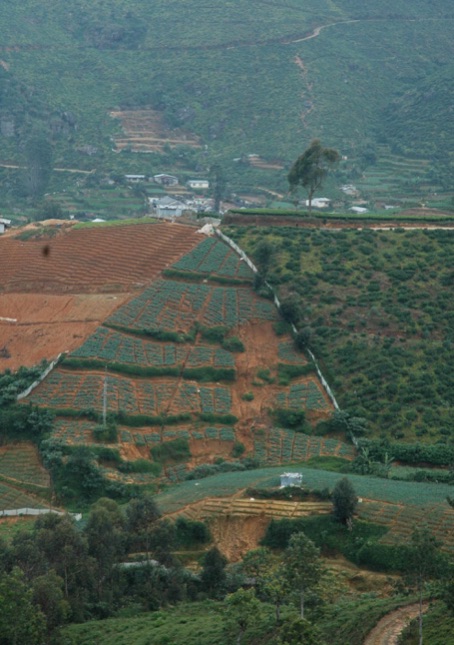A Brief Colonial History Of Ceylon(SriLanka)
Sri Lanka: One Island Two Nations
A Brief Colonial History Of Ceylon(SriLanka)
Sri Lanka: One Island Two Nations
(Full Story)
Search This Blog
Back to 500BC.
==========================
Thiranjala Weerasinghe sj.- One Island Two Nations
?????????????????????????????????????????????????Tuesday, December 6, 2016
Adaptation – Part II

By Ranil Senanayake –December 5, 2016
Preparing for the future by looking back.
Understanding the issues and options before us.
The central mountains of Sri Lanka drain radially to the sea, through
103 distinct watersheds. A watershed of a river is that area of land
whose rainfall feeds the river and begins in the mountains. As commented
by the Rt. Hon. D.S. Senanayake :
“With the evidence daily accumulating of the wisdom of our forefathers,
we need scarcely doubt that it was not merely the idea of making the
mountain country difficult of approach by the foreign invader that
caused them to preserve unfilled and uncleared the dense vegetation of
their mountain slopes. We may readily believe that they deliberately
left these untouched in order to provide that abundant supply of water
on which they might draw for the benefit of man.”
This ‘uncleared and dense vegetation’ that evoked so much gratitude in
our founding father, had been existant on the mountains of Sri Lanka for
a period exceeding 20 million years and over this time built a soil
that contained a treasure in organic matter. Soil organic matter is the
living fraction that drives the ecosystem that lies above it.
Sustainable agriculture and forestry will be an impossibility without
the optimum levels of organic matter for that soil. The organic matter
of soil when extracted is seen as a dark, amorphous solid mass. On
closer examination this ‘solid mass’ is seen to be comprised of billions
of organisms. In fact, any one acre of farmyard soil contains as much
biomass as an Elephant. One gram of ordinary farmyard soil can contain
over 1 billion individual bacteria, over 100 million individual
actinomyctes and over 1 kilometer of fungal hyphpae, notwithstanding
plants like algae and animals like collembolids, nematodes or worms. In
Sri Lanka the soil ecosystem is further enhanced by presence of many
genera and species of soil dwelling snakes, lizards etc; all massive
predators in this ecosystem that suggest the age and the massive nature
of the soil bank this nation once possessed.
A forest soil, if undisturbed will develop humic acid molecues that
allow carbon to be sequestered in the soil for periods exceeding 15,000
years. These soils are deep and ‘spongy’ allowing them to soak up and
retain rainwater, to feed springs and rivers below. This function of our
mountain forests came to an end with the advent of the colonial
adventure. Fredrick Lewis in his book Sixty Four Years in CEYLON makes
this observation on the destruction of the mountain forests in the Agra
Patana area;
“I know of no more awe-inspiring sight, than that of a thousand acres on
fire. Sheets of flame appear to leap into the air, and yell with a sort
of devilish delight at their victory over the magnificent trees they
are reducing into charred masses of cinder and charcoal. It is more than
impressive, it is fearful, yet grand ! After the fire has completed its
work, the land is covered with .black logs, lumps of charred timber,
masses, and often great fragments of stones, broken by the heat that has
swept over them. A deep black covers the landscape; impressive, but
depressing.
It was in a burned wilderness like this, that I found my new home. It lay at the extreme end of one of the many blocks of land that had been simultaneously burned off. My path, for road it could not be then called led over hundreds of fallen and charred logs, and followed the valley of the Agra stream……. When morning broke upon the day following the events recorded at the conclusion of the last chapter, I found myself gazing upon a scene not altogether unfamiliar to me. All around me lay hundreds of charred black logs, stumps in fantastic shapes and outlines: fallen branches, broken and distorted by fire: cinder heaps, and little rivulets of sodden ash: all indicative of the fierce, merciless fire that but a few weeks ago, had raged over a spot that so lately had been a beautiful forest land. It was now a blackened wilderness, to be changed into fields of coffee, by the labour and patience of man. A strange picture; fascinating in one respect: fearful in another and yet so full of a strange mixture of possibilities was this wild heap of ruins, this uncouth mass of slaughtered giants of an inarticulate, yet eloquent world, to be transformed by , industry in the pursuit of fleeting wealth.”
It was in a burned wilderness like this, that I found my new home. It lay at the extreme end of one of the many blocks of land that had been simultaneously burned off. My path, for road it could not be then called led over hundreds of fallen and charred logs, and followed the valley of the Agra stream……. When morning broke upon the day following the events recorded at the conclusion of the last chapter, I found myself gazing upon a scene not altogether unfamiliar to me. All around me lay hundreds of charred black logs, stumps in fantastic shapes and outlines: fallen branches, broken and distorted by fire: cinder heaps, and little rivulets of sodden ash: all indicative of the fierce, merciless fire that but a few weeks ago, had raged over a spot that so lately had been a beautiful forest land. It was now a blackened wilderness, to be changed into fields of coffee, by the labour and patience of man. A strange picture; fascinating in one respect: fearful in another and yet so full of a strange mixture of possibilities was this wild heap of ruins, this uncouth mass of slaughtered giants of an inarticulate, yet eloquent world, to be transformed by , industry in the pursuit of fleeting wealth.”



